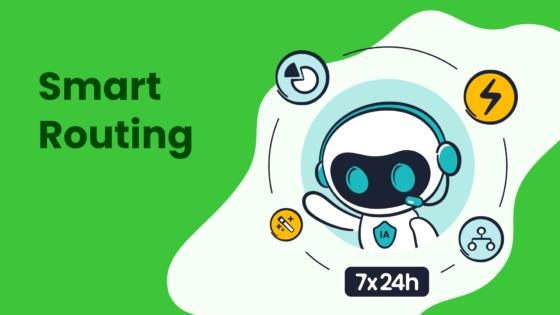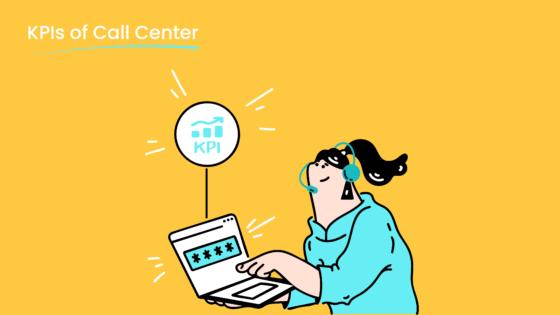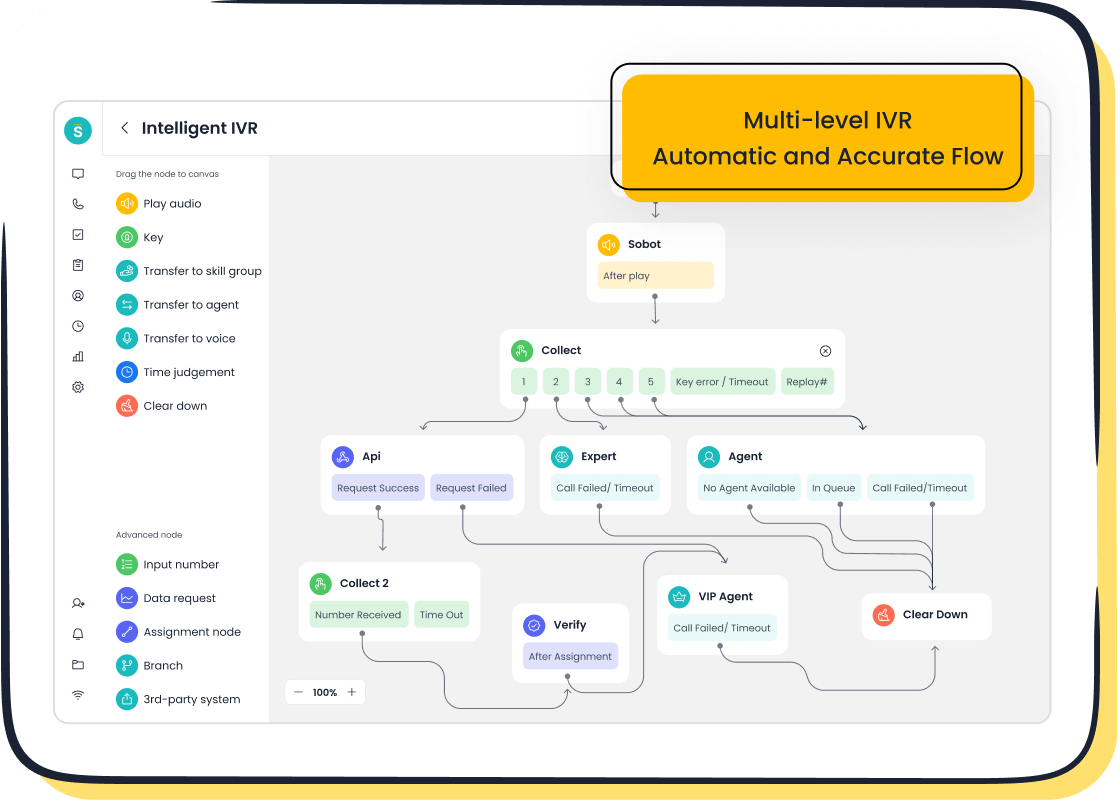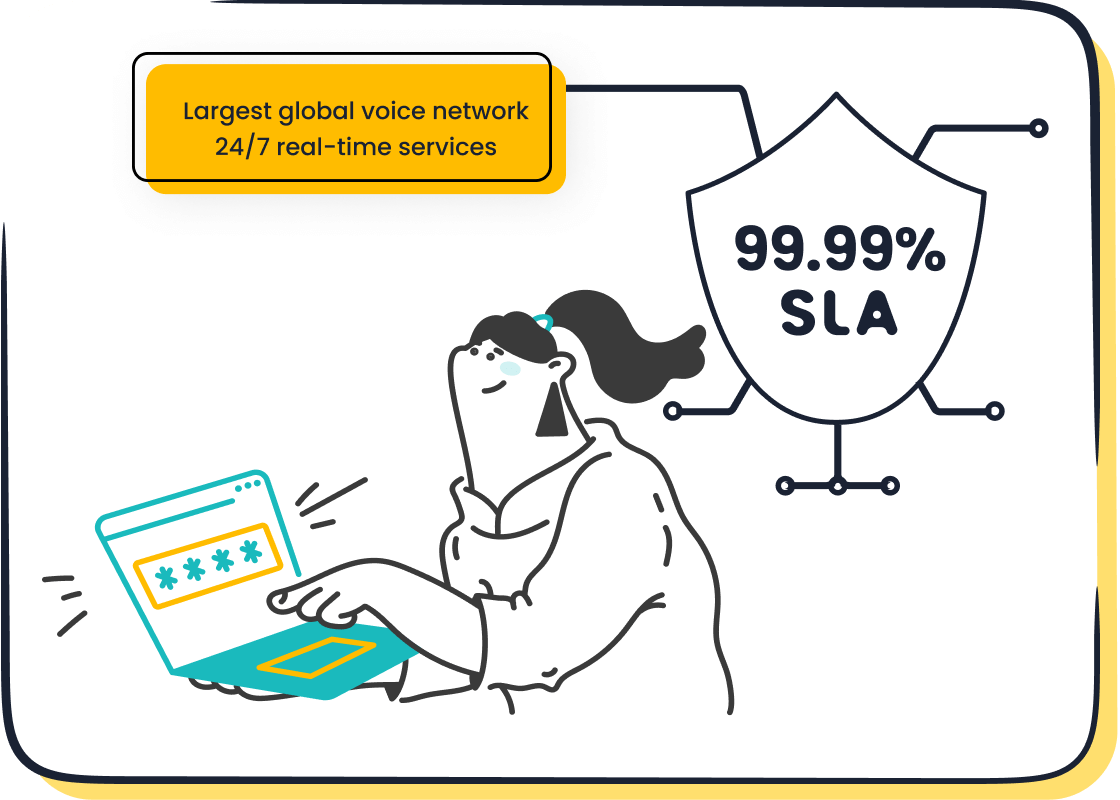Inbound Call Center Solutions for Better Customer Service

Inbound call center solutions play a pivotal role in transforming how you deliver customer service. They enable businesses to handle inquiries efficiently while ensuring customer satisfaction. For instance, call centers with a First Call Resolution (FCR) rate of 70-75% demonstrate effective service delivery, which directly impacts customer loyalty. Additionally, 82% of businesses recognize the value of call data in identifying service gaps. By adopting advanced tools like Sobot’s intelligent solutions, you can leverage AI to enhance operational efficiency and provide a seamless experience for your customers.
Benefits of Inbound Call Center Solutions

Enhancing Customer Experience with Personalized Interactions
Personalized interactions are the cornerstone of an enhanced customer experience. When you address customers by name or reference their past interactions, they feel valued and understood. This approach builds trust and loyalty, encouraging them to return to your business. For example, inbound call center software enables agents to access unified customer data, ensuring every interaction is tailored to the individual’s needs.
Tip: Use intelligent call routing systems to connect customers with the most suitable agents. This reduces wait times and ensures faster resolutions.
Studies show that personalized assistance significantly boosts customer satisfaction. Customers who receive tailored support are more likely to recommend your brand to others. The table below highlights the impact of personalized interactions on customer satisfaction metrics:
| Aspect | Impact on Customer Satisfaction |
|---|---|
| Enhanced Customer Experience | Customers feel valued and understood, leading to loyalty. |
| Improved Customer Satisfaction | Personalized assistance increases likelihood of satisfaction. |
By leveraging inbound call center solutions, you can transform the customer experience and foster long-term relationships.
Improving Operational Efficiency and Reducing Costs
Inbound call center software plays a vital role in streamlining operations and reducing costs. Advanced features like AI-driven call routing and automated workflows minimize inefficiencies, allowing your team to focus on complex tasks. This not only improves productivity but also reduces operational expenses.
AI-driven cost optimization is a game-changer. By automating repetitive tasks, you can allocate resources more effectively. For instance, intelligent IVR systems handle routine inquiries, freeing agents to address more critical issues. The table below outlines key metrics that demonstrate how operational efficiency impacts cost reduction:
| Metric | Formula | Industry Benchmark | Cost Impact |
|---|---|---|---|
| Cost Per Call | Total Costs / Number of Calls | Varies by industry | Direct impact on profitability |
| First Call Resolution (FCR) | (Calls Resolved on First Contact / Total Calls) * 100 | 70-80% | Reduces repeat calls and improves CSAT |
| Average Handle Time (AHT) | (Total Talk Time + Hold Time + After-Call Work) / Number of Calls | Varies by industry and call complexity | Impacts agent productivity and staffing needs |
| Occupancy Rate | (Total Time Spent on Call-Related Activities / Total Logged-in Time) * 100 | 70-85% (excluding breaks) | Reflects agent utilization and potential for increased efficiency |
| Call Abandonment Rate | (Abandoned Calls / Total Calls Offered) * 100 | Aim for <5% | Indicates customer frustration and potential lost business |
Businesses that implement inbound call center services report significant cost savings, ranging from 15-25%. Additionally, they experience a 1.7x increase in customer retention and a 1.9x boost in average order value. These advantages make inbound calling services an essential investment for any organization.
24/7 Availability and Scalability for Growing Businesses
Round-the-clock availability is crucial in today’s fast-paced world. Customers expect support at any time, and inbound call center solutions make this possible. With features like AI-powered voicebots and global number availability, you can provide seamless service across different time zones.
Note: 24/7 availability not only enhances customer satisfaction but also gives you a competitive edge. Businesses that offer continuous support stand out from competitors with limited hours.
The benefits of 24/7 availability include:
- Enhanced Customer Satisfaction: Customers appreciate immediate assistance, leading to higher satisfaction levels.
- Competitive Advantage: Continuous support differentiates your business from others.
- Global Reach: Essential for businesses operating in multiple time zones.
- Increased Revenue: Immediate support boosts sales and conversions.
Scalability is another key advantage of inbound call center software. As your business grows, you can easily add new agents or expand your operations. Statistics reveal that businesses using scalable call center services experience a 40-60% faster onboarding process for new agents. This flexibility ensures you can meet increasing customer demands without compromising service quality.
Inbound call center solutions empower you to deliver exceptional service, reduce costs, and scale effortlessly. By adopting these tools, you can achieve customer experience transformation and drive long-term success.
Building Customer Loyalty Through Reliable Support
Reliable customer support is the foundation of building lasting relationships with your customers. When customers know they can count on your team to resolve their issues promptly and effectively, they develop trust in your brand. This trust often translates into loyalty, which drives repeat business and positive word-of-mouth recommendations.
Why Reliability Matters in Customer Support
Reliability in customer support ensures customers feel valued and respected. When you consistently deliver high-quality service, customers are more likely to stay loyal to your brand. Studies show that businesses offering dependable call center services experience higher customer satisfaction rates. For example, resolving issues on the first call demonstrates your commitment to efficiency and care.
Tip: Train your agents to handle inquiries with empathy and professionalism. This approach enhances the quality of service and leaves a lasting impression on customers.
How Inbound Call Center Services Foster Loyalty
Inbound call center services play a crucial role in maintaining reliability. Features like intelligent call routing and unified customer data ensure your team can address inquiries quickly and accurately. These tools reduce wait times and eliminate the frustration of repeating information, creating a seamless experience for your customers.
Here’s how inbound calling services contribute to loyalty:
- Consistency: Customers receive the same high-quality service every time they contact your team.
- Efficiency: Faster resolutions reduce customer effort, increasing satisfaction.
- Personalization: Access to unified data allows agents to tailor interactions to individual needs.
Advantages of Reliable Support for Your Business
Reliable support offers several advantages for your business. It strengthens customer loyalty, which leads to higher retention rates and increased revenue. Loyal customers are also more likely to recommend your brand, expanding your reach without additional marketing costs.
| Benefit | Impact on Business |
|---|---|
| Increased Retention | Loyal customers stay longer, boosting revenue. |
| Positive Recommendations | Satisfied customers promote your brand to others. |
| Higher Customer Satisfaction | Reliable support improves overall satisfaction levels. |
Actionable Steps to Enhance Reliability
To improve the reliability of your customer support, focus on the following steps:
- Invest in Training: Equip your agents with the skills to handle diverse inquiries effectively.
- Leverage Technology: Use inbound call center services to streamline operations and improve the quality of service.
- Monitor Performance: Regularly analyze call data to identify areas for improvement.
- Prioritize First Call Resolution: Aim to resolve issues on the first contact to boost customer satisfaction.
By implementing these strategies, you can build a reputation for dependable support and foster long-term loyalty among your customers.
Key Features of Inbound Call Center Software

Intelligent Call Routing and IVR Systems

Efficient call handling begins with intelligent call routing and IVR systems. These features ensure customers connect with the right agent or department based on their needs. By using automated workflows, you can reduce wait times and improve the quality of service. For example, Sobot’s inbound call center software offers drag-and-drop IVR customization, allowing you to create menus and route calls seamlessly.
Tip: Use IVR systems to handle routine inquiries, freeing agents to focus on complex issues.
Metrics like average handling time (AHT) and first-call resolution (FCR) highlight the effectiveness of these systems. The table below shows how intelligent call routing impacts performance:
| Metric | Description |
|---|---|
| Average Handling Time (AHT) | Measures how efficiently calls are resolved, impacting customer satisfaction and staff workload. |
| First Call Resolution (FCR) | Tracks the percentage of calls resolved on the first interaction, reducing repeat contacts. |
| Customer Satisfaction Score (CSAT) | Gauges customer happiness post-call, reflecting service quality and agent performance. |
| Net Promoter Score (NPS) | Measures customer loyalty by evaluating their likelihood to recommend your services. |
By implementing intelligent call routing, you can reduce abandoned call rates and enhance customer satisfaction.
CRM Integration for Unified Customer Data
CRM integration is essential for consolidating customer data and improving service quality. With inbound call center software, you can access a unified view of customer interactions, enabling personalized and proactive engagement. For instance, Sobot’s cloud-based contact center integrates seamlessly with CRM systems, offering real-time insights and automation.
Note: Unified customer data reduces repetition of issues and improves first-call resolution rates.
The table below highlights the benefits of CRM integration:
| Metric | Description |
|---|---|
| Personalization | Tailors offerings and communications based on a complete understanding of customer history and needs. |
| Efficiency and Automation | Streamlines repetitive tasks, boosting productivity and reducing errors in customer data management. |
| Real-Time Insights | Provides up-to-date customer data, enabling timely responses to customer needs and opportunities. |
| Improved Customer Service | Offers a unified view of customer journeys, enhancing personalized service and proactive engagement. |
| Data-Driven Decisions | Consolidates customer records for informed decision-making aligned with customer needs and business goals. |
| Efficiency in Operations | Automates data collection, improving operational efficiency and allowing focus on strategic activities. |
CRM integration transforms your customer support platform into a powerful tool for delivering exceptional service.
Real-Time Analytics and Performance Monitoring

Real-time analytics provide actionable insights into call center operations. With inbound call center software, you can monitor metrics like call handle time, resolution rates, and customer satisfaction scores. Sobot’s real-time reporting tools allow you to set custom alerts, coach agents during calls, and reassign tasks seamlessly.
Tip: Use real-time analytics to identify emerging issues and optimize agent performance.
Key metrics include:
- Call handle time: Tracks the average duration of calls, helping you assess efficiency.
- Call resolution rate: Measures the percentage of calls resolved on the first contact.
- Customer satisfaction scores: Reflect the quality of service provided by your team.
Monitoring these metrics ensures your call center delivers consistent and high-quality service. Additionally, real-time reporting helps reduce abandoned call rates, which should ideally remain below 10%.
Multichannel Support for Seamless Communication

Providing multichannel support ensures your customers can reach you through their preferred communication channels. Whether it’s voice, email, social media, or live chat, offering multiple options creates a seamless experience. Customers no longer need to repeat themselves when switching between channels, as all interactions are unified in one system. This approach not only saves time but also enhances satisfaction.
Tip: Use a unified workspace to manage all customer interactions in one place. This reduces confusion and improves response times.
Multichannel support has become the new industry standard. Customers expect businesses to provide consistent service across platforms. Meeting these expectations can significantly benefit your brand. Here are some key advantages:
- Increased brand awareness
- Improved visibility
- Enhanced ease of use
- Better customer satisfaction
Businesses that adopt multichannel solutions often see a boost in customer loyalty. By making communication easier, you show customers that their convenience matters. This builds trust and encourages repeat business.
Additionally, multichannel support helps you stay competitive. As customer expectations evolve, businesses that fail to adapt risk losing their audience. Offering seamless communication across platforms ensures you remain relevant in a fast-changing market.
Security and Compliance for Data Protection

Protecting customer data is critical in today’s digital landscape. Inbound call centers handle sensitive information, making security and compliance a top priority. Adhering to regulations like GDPR, CCPA, and PCI-DSS ensures your business meets legal standards while safeguarding customer trust.
Note: Inform customers about call recording and obtain their consent to comply with legal requirements.
Here are some key measures that enhance data protection:
- GDPR: Enforces strict rules for handling EU citizens’ data.
- CCPA: Protects California consumers by requiring transparency in data handling.
- PCI-DSS: Sets security standards for managing credit card information.
Routine audits and third-party validations further strengthen your compliance efforts. Engaging external experts to review your practices adds credibility and ensures adherence to regulations. Appointing a Data Protection Officer (DPO) can also help maintain high standards.
For call centers handling health information, HIPAA compliance is essential. It protects patient privacy and ensures sensitive data remains secure. Familiarity with TCPA and DNC regulations also helps you avoid legal penalties and maintain respectful communication.
By prioritizing security and compliance, you not only protect customer data but also build a reputation for reliability. Customers are more likely to trust businesses that demonstrate a commitment to safeguarding their information.
Comparison of Top Inbound Call Center Software Providers
Overview of Leading Providers in the Market
When choosing the best inbound call center service providers, you need to understand the market leaders and their unique offerings. These providers leverage advanced technologies like cloud computing, AI, and analytics to improve operational efficiency and customer satisfaction. Many also integrate omnichannel capabilities, ensuring seamless communication across platforms.
Here are some notable providers:
- Teleperformance: Improved customer satisfaction (CSAT) from 62% to 89% by using advanced analytics and omnichannel technology.
- Concentrix: Enhanced self-service payment rates by 2.8% and boosted CSAT by 7% with conversational AI.
- Alorica: Achieved top Voice of the Customer scores by adapting to program changes and enhancing service quality.
- Foundever: Delivered a 61 Net Promoter Score (NPS), 50% above the industry average, through multilingual support.
- Five Star Call Centers: Exceeded expectations in staffing flexibility and customer satisfaction for government projects.
These companies demonstrate how inbound call center software can transform customer service. By adopting similar solutions, you can achieve measurable improvements in efficiency and satisfaction.
Key Features and Benefits of Each Provider
Each call center software provider offers unique features tailored to different business needs. The table below compares some of the top options:
| Company Name | Key Features | Pros | Cons | Recommended for |
|---|---|---|---|---|
| Appy Pie | Affordable, scalable, cloud-based | Easy to use, reliable | Limited features | Small businesses |
| Salesforce Service Cloud | Analytics, IVR, CRM integration | Tracks sales, simple API integrations | Steep learning curve | Small & medium businesses |
| Nice CXone | Customer experience, inbound & outbound | Data-driven results, user-friendly | Difficult analytics | Small & medium businesses |
| LiveAgent | Omnichannel, skill-based routing | Intuitive, organized view | Limited technical support | Small to large businesses |
| Zendesk | Personalized solutions, low TCO | Metrics tracking, omnichannel | Slower support | Small to large businesses |
For example, Sobot’s inbound call center software stands out with its intelligent IVR, AI-powered voicebots, and seamless CRM integration. These features ensure personalized interactions and efficient call handling, making it ideal for businesses of all sizes.
Pricing Models and Scalability Options
Understanding pricing plans and scalability options is crucial when selecting the best call center software. Providers typically offer two main cost structures:
| Type | Cost Structure | Scalability Options |
|---|---|---|
| Cloud-Based | Monthly per user charges, minimal upfront costs, automatic updates and security patches | Easy to add/remove users, agents can work from anywhere |
| On-Premises | High initial investment (hardware, software, setup), ongoing maintenance costs | Limited scalability, often requires additional hardware for growth |
Cloud-based solutions like Sobot’s Voice/Call Center offer competitive pricing with scalable plans. You can start small and expand as your business grows. This flexibility ensures you meet increasing customer demands without overextending your budget. For instance, Sobot’s platform supports global telephony contacts and provides a 99.99% uptime, making it a reliable choice for businesses aiming to scale efficiently.
By comparing pricing models and scalability, you can identify the solution that aligns with your operational goals and budget.
Industry-Specific Solutions and Use Cases
Inbound call center solutions are not one-size-fits-all. Different industries face unique challenges that require tailored approaches. By adopting industry-specific solutions, you can address these challenges effectively and enhance customer satisfaction.
How Industry-Specific Solutions Solve Challenges
Each industry has distinct needs. For example, the healthcare sector often struggles with long wait times and communication delays. In contrast, the telecommunications industry deals with compliance verification and claims processing. Tailored inbound call center solutions can resolve these issues efficiently. The table below illustrates how specific solutions address industry challenges:
| Industry | Challenges Addressed | Solutions Provided |
|---|---|---|
| Healthcare | Long wait times, administrative inefficiencies, communication delays | Streamlined appointment scheduling, patient follow-ups, inquiries |
| Telecommunications | Customer inquiries, compliance verification, claims processing | Tailored AI agents for efficient customer service and compliance management |
These examples highlight the importance of choosing the best call center software for your industry. By implementing solutions designed for your specific needs, you can improve operational efficiency and customer satisfaction.
Real-World Use Cases
Many businesses have already benefited from industry-specific solutions. For instance, Samsung partnered with Sobot to unify its communication channels and improve data connectivity. This collaboration resulted in a 30% increase in agent efficiency and a 97% customer satisfaction rate. Similarly, companies in retail and e-commerce use Sobot's omnichannel solutions to provide seamless support across platforms, boosting customer loyalty.
Outsourced call centers also play a vital role in delivering industry-specific solutions. They allow businesses to leverage specialized expertise without investing in extensive in-house resources. This approach is particularly beneficial for small and medium-sized enterprises looking to scale their operations.
By focusing on industry-specific needs, you can ensure your inbound call center delivers the best possible service to your customers.
Why Sobot's Voice/Call Center Stands Out
Sobot's Voice/Call Center offers a comprehensive solution that caters to businesses of all sizes. Its advanced features and user-friendly design make it one of the best inbound call center service providers in the market.
Key Features That Set Sobot Apart
- Intelligent IVR and Call Routing: Sobot's drag-and-drop IVR customization allows you to create menus and route calls seamlessly. This feature reduces wait times and ensures customers connect with the right agent.
- AI-Powered Voicebot: The AI-powered voicebot handles routine inquiries, freeing agents to focus on complex issues. This improves efficiency and customer satisfaction.
- Global Number Availability: With access to phone numbers worldwide, Sobot supports businesses operating across multiple regions.
- Real-Time Analytics: Sobot provides actionable insights into call center performance, helping you optimize operations and improve service quality.
- 99.99% Uptime: Sobot's stable system ensures uninterrupted service, making it a reliable choice for businesses.
Benefits of Choosing Sobot
Sobot's Voice/Call Center goes beyond basic functionality. It integrates seamlessly with CRM systems, providing a unified view of customer interactions. This feature enables personalized service, which is crucial for building customer loyalty. Additionally, Sobot's solutions are scalable, allowing you to expand your operations as your business grows.
For businesses seeking the best call center software, Sobot offers a cost-effective and efficient solution. Its focus on innovation and customer-centricity ensures you receive a platform that meets your unique needs. Whether you're in healthcare, telecommunications, or retail, Sobot's Voice/Call Center can help you achieve your goals.
Tip: Explore Sobot's Voice/Call Center to experience the benefits of a tailored, reliable, and scalable solution.
How to Choose the Right Inbound Call Center Solution
Identifying Your Business Needs and Goals
Understanding your business needs and goals is the first step in selecting the right inbound call center software. Start by evaluating the services you offer and ensure they align with your operational requirements. Consider the technology infrastructure you currently have and assess whether it supports seamless integration with new software. Analyze the expertise and training of your staff to identify gaps that need addressing. Scalability and flexibility in services are also critical, especially if your business is growing. Lastly, review pricing structures to ensure they fit within your budget and cost considerations.
Tip: Setting SMART (Specific, Measurable, Achievable, Relevant, Time-bound) goals helps you align your call center's objectives with customer satisfaction and business growth. For example, clear goals can reduce agent turnover and improve efficiency.
| Evidence | Explanation |
|---|---|
| Setting SMART goals tightly coupled with customer needs enables your call center to become a strategic asset, driving customer satisfaction, loyalty, and business growth. | This highlights the direct link between well-defined goals and positive business outcomes, reinforcing the need for alignment with business objectives. |
| Clear goals and direction keep agents engaged and reduce call center turnover while efficient processes and proactive planning prevent wasted time and money. | This emphasizes that alignment not only benefits customer satisfaction but also improves internal operations and employee retention. |
Evaluating Features and Integration Capabilities
When choosing inbound call center software, focus on features that align with your business needs and goals. Look for intelligent call routing, CRM integration, and real-time analytics. These features improve efficiency and enhance customer interactions. CRM integration, in particular, provides a unified view of customer data, enabling personalized service and faster resolutions.
Note: Ensure the software integrates seamlessly with your existing systems. This reduces disruptions and maximizes the availability of resources.
Multichannel support is another essential feature. It allows customers to contact you through their preferred channels, such as voice, email, or social media. This flexibility improves customer satisfaction and ensures consistent service across platforms. Additionally, evaluate the software's scalability to accommodate future growth.
Budget Considerations and ROI Analysis
Budget and cost considerations play a significant role in selecting the right inbound call center software. Compare the costs of traditional call centers with AI-enhanced solutions to understand the potential return on investment (ROI). AI-powered systems often reduce operational costs while increasing efficiency and profitability.
| Aspect | Traditional Call Center | AI-Enhanced Call Center |
|---|---|---|
| Annual Revenue | $1.2-1.8 million | Increased by 30-40% |
| Net Profit Margin | 8-12% | 15-22% |
| Call Handling Efficiency | 1,000 calls/day | 30-40% more calls |
| Training & QA Cost Reduction | N/A | 25-30% reduction |
| Operational Hours | Limited | 24/7 operation |
| Profitability Improvement | N/A | 50-100% improvement |
Companies using AI for quality monitoring report 15-20% improvements in key performance indicators like average handle time and customer satisfaction. A 5% increase in customer retention can lead to a profit increase of 25-95%. By integrating AI technologies, you not only reduce costs but also enhance customer lifetime value, creating a significant profit multiplier effect.
Importance of Scalability and Future Growth
Scalability is essential for businesses aiming to grow while maintaining high-quality customer service. Inbound call center solutions designed for scalability allow you to adapt to changing demands without compromising efficiency. Whether your call volumes increase during peak seasons or your business expands into new markets, scalable tools ensure smooth operations.
Investing in scalable solutions offers long-term benefits. These tools streamline processes, enabling your team to respond promptly to customer inquiries. They also minimize costs associated with technology upgrades and staffing, making them cost-effective. Additionally, scalable systems handle varying call volumes seamlessly, ensuring consistent service quality. The table below highlights these advantages:
| Benefit | Description |
|---|---|
| Operational Efficiency | Scalable solutions streamline processes, allowing teams to operate more efficiently and respond promptly to customer inquiries. |
| Cost-effectiveness | Investing in scalable tools minimizes costs linked to technology and staff while enhancing productivity. |
| Adaptability | These solutions enable businesses to handle varying call volumes without compromising service quality, accommodating growth seamlessly. |
By choosing scalable call center software, you prepare your business for future growth. This adaptability ensures you can meet customer expectations while staying competitive in a dynamic market.
Tip: Opt for solutions that offer flexible pricing plans and easy integration. These features simplify scaling and reduce operational disruptions.
Assessing Customer Support and Training Services
Effective customer support and training services are critical when implementing inbound call center solutions. Vendors offering comprehensive onboarding processes help your team understand new systems and workflows quickly. This ensures a smooth transition and maximizes the benefits of the software.
Training programs tailored to your needs improve adoption rates. Tools like digital adoption platforms provide contextual training, allowing your team to learn at their own pace. Real-time guidance ensures they grasp complex features without feeling overwhelmed. Monitoring performance metrics, such as completion times and engagement rates, helps identify areas for improvement. Feedback collection through in-app surveys further enhances the onboarding experience. The table below outlines these key aspects:
| Evidence Type | Description |
|---|---|
| Comprehensive Training | Effective training is essential for vendors to understand organizational systems and workflows. |
| Digital Adoption Platforms | Tools like Whatfix provide contextual training, enabling vendors to learn at their own pace with real-time guidance. |
| Performance Monitoring | Tracking metrics such as completion times and engagement rates helps identify areas for improvement in the onboarding process. |
| Feedback Collection | In-app surveys allow for gathering vendor feedback, which is crucial for continuous improvement of the onboarding experience. |
Strong customer support during onboarding ensures your team can use the software effectively. This reduces downtime and boosts productivity. By prioritizing training and support, you set your business up for success with inbound call center solutions.
Note: Choose vendors that offer ongoing support and regular updates. This ensures your software remains effective as your business evolves.
Actionable Tips for Implementing Inbound Call Center Solutions
Training Your Team for Effective Use
Proper training ensures your team can fully utilize the call center features and deliver exceptional service. Start by implementing diverse training methodologies to address different learning styles. For example, simulation-based training bridges the gap between theory and practice, while microlearning maximizes engagement through short, focused lessons. Gamification can make learning enjoyable and improve performance monitoring. Peer-to-peer mentoring fosters a culture of feedback, and AI-powered coaching supports ongoing skill development.
| Training Methodology | Performance Improvement |
|---|---|
| Simulation-based training | Bridges the gap between theory and practice. |
| Microlearning | Maximizes engagement through diverse learning. |
| Gamification | Enhances learning and performance monitoring. |
| Peer-to-peer mentoring | Fosters a culture of feedback and improvement. |
| AI-powered performance coaching | Supports ongoing learning and adaptation. |
These methods not only enhance agent confidence but also reduce turnover and increase productivity. A well-trained team improves the quality of service, leading to better customer satisfaction.
Tip: Regularly update training programs to keep your team informed about new call center software features and best practices.
Monitoring Performance and Gathering Customer Feedback
Monitoring performance helps you identify areas for improvement and maintain high-quality service. Use metrics like Customer Satisfaction Score (CSAT), Average Speed of Answer (ASA), and Net Promoter Score (NPS) to evaluate your team’s effectiveness. For instance, CSAT reflects customer happiness, while ASA measures wait times, which directly impact satisfaction levels.
| Metric | Description |
|---|---|
| Customer Satisfaction Score | Indicates customer happiness with service, correlating with loyalty and business growth. |
| Average Speed of Answer | Measures efficiency by showing wait times, impacting customer satisfaction and frustration levels. |
| Net Promoter Score | Assesses customer loyalty and likelihood to recommend, providing insights into overall sentiment. |
Gathering customer feedback is equally important. Use surveys and follow-up calls to understand customer needs and expectations. This data helps you refine your inbound calling services and enhance the customer experience.
Note: Combine performance monitoring with customer feedback to create a comprehensive strategy for improving your customer support platform.
Leveraging Analytics for Continuous Improvement
Analytics play a crucial role in optimizing call center operations. By monitoring key metrics like Average Handle Time (AHT) and First Call Resolution (FCR), you can identify inefficiencies and implement targeted improvements. For example, a call center that used analytics to review call routing reduced wait times by 45% and improved satisfaction scores by 30%.
- Monitor AHT to assess operational efficiency and customer satisfaction.
- Track FCR to measure the effectiveness of resolving issues on the first contact.
- Use CSAT to gauge customer feedback and overall service quality.
Real-time reporting tools provide actionable insights, allowing you to make data-driven decisions. Automated scheduling systems optimize staffing based on real-time data, ensuring your team can handle varying call volumes effectively. These advantages improve the quality of service and enhance customer loyalty.
Tip: Implement a Continuous Improvement Framework to regularly review processes and adapt to changing customer needs.
Partnering with Reliable Providers Like Sobot
Choosing the right provider for your call center software is essential for delivering exceptional customer service. Reliable providers like Sobot offer solutions that enhance efficiency, improve customer satisfaction, and support your business growth. With Sobot, you gain access to advanced tools designed to streamline operations and elevate your customer interactions.
Why Reliability Matters
Reliability ensures your call center operates smoothly without interruptions. Sobot guarantees a system uptime of 99.99%, which minimizes downtime and keeps your operations running efficiently. This level of stability is critical for businesses that handle high call volumes or operate across multiple time zones. For example, Sobot’s global network spans 110 points of presence in 93 cities, ensuring consistent service worldwide.
Tip: Partnering with a provider that prioritizes reliability helps you build trust with your customers and maintain high satisfaction levels.
Key Benefits of Partnering with Sobot
Sobot’s call center software stands out due to its innovative features and customer-centric approach. Here are some benefits you can expect:
- Advanced Technology: Sobot integrates AI-powered voicebots and intelligent IVR systems to automate routine tasks and improve efficiency.
- Scalability: The platform adapts to your business needs, allowing you to add agents or expand operations effortlessly.
- Global Reach: With access to phone numbers worldwide, Sobot supports businesses in multiple regions.
- Unified Workspace: Agents can manage calls and customer data in one place, reducing complexity and improving response times.
Real-World Success Stories
Sobot’s solutions have helped businesses like Samsung achieve remarkable results. By implementing Sobot’s call center software, Samsung improved agent efficiency by 30% and achieved a customer satisfaction rate of 97%. This demonstrates how partnering with Sobot can transform your customer service operations.
Note: Explore Sobot’s Voice/Call Center to experience the benefits of a reliable and scalable solution tailored to your needs. Visit Sobot’s official website for more information.
Inbound call center solutions transform how you deliver customer service. They improve efficiency, reduce costs, and enhance customer satisfaction. Features like intelligent call routing, CRM integration, and real-time analytics streamline operations and ensure personalized interactions. By choosing the right inbound call center services, you can scale your business and meet growing demands. Sobot’s Voice/Call Center offers a reliable, scalable, and innovative platform tailored to your needs. Explore its advanced features to elevate your customer experience and drive long-term success. Visit Sobot’s official website to learn more.
FAQ
What is an inbound call center solution?
An inbound call center solution is a system designed to manage incoming customer calls. It helps businesses handle inquiries, provide support, and improve customer satisfaction. Features like intelligent call routing and CRM integration ensure efficient and personalized service.
How does intelligent call routing work?
Intelligent call routing uses predefined rules to direct calls to the most suitable agent or department. It considers factors like agent skills, customer history, and call priority. This reduces wait times and ensures faster resolutions.
Can inbound call center software integrate with existing systems?
Yes, most inbound call center software, including Sobot’s solutions, integrates seamlessly with existing systems like CRM or ERP. This ensures a unified view of customer data and enhances operational efficiency.
Why is 24/7 availability important for customer service?
24/7 availability ensures customers can reach you anytime, regardless of their location or time zone. It improves customer satisfaction, builds trust, and gives your business a competitive edge.
How does Sobot ensure data security?
Sobot prioritizes data security with features like encrypted data transfer, compliance with regulations (e.g., GDPR, CCPA), and regular audits. These measures protect sensitive customer information and maintain trust.
See Also
Best Reviewed Contact Center Solutions for the Year 2024
Key Features to Look for in CRM Call Center Software
Comprehensive Guide to Omnichannel Call Center Solutions
Best Practices for Quality Management in Call Centers
Ten Essential Steps for Implementing Omnichannel Contact Centers
